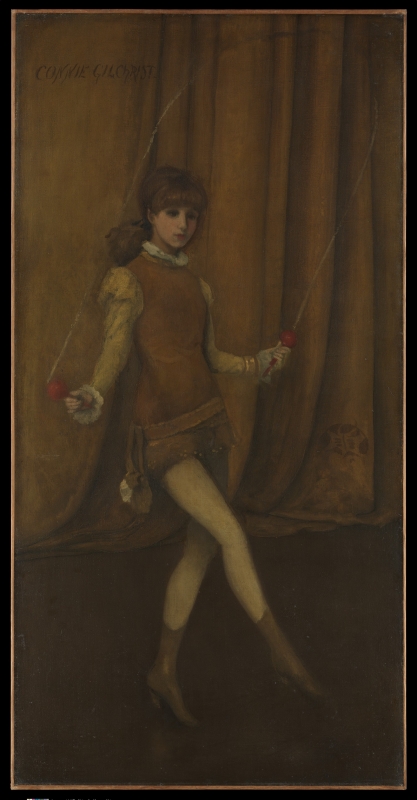Composition
Four drawings of Connie Gilchrist, related to this painting, are recorded. Sketch of 'Harmony in Yellow and Gold: The Gold Girl - Connie Gilchrist' [M.0709], reproduced above, which was published in Blackburn 1879 [more] , may have been done for reproduction by another hand.
Others may be studies done in preparation or drawings by Whistler after the painting: Sketch of 'Harmony in Yellow and Gold: The Gold Girl - Connie Gilchrist' [M.0710], now in the British Museum; Sketch of 'Harmony in Yellow and Gold: The Gold Girl - Connie Gilchrist' [M.0711], which has not been located; and Connie Gilchrist [M.0712] in the Lucas Collection, Baltimore. They are more lively than the painting, conveying the movement of the figure with curving, broken lines, in a much more effective manner than does the painting.
Technique
It is on a fine canvas that has been lined with a fine weave canvas, but the glue lining has caused some blisters or dimpling. The stretcher has a Blanchet stamp, and the canvas may have been acquired in Paris. There are some scumbled semi-opaque layers of blue and dark purple paint. The colour may have changed, with the purplish-red pigment fading, while the yellow tones in the lower half of the painting were probably stronger (they are stronger in the area protected by the rebate of the picture frame). 1
After it was bought by Henry Du Pré Labouchere (1831-1912) in 1879 he let Whistler have it back 'to work on it' but, according to the Pennells, Whistler 'had not touched the canvas' but wanted to destroy it. 2 Jacques Émile Blanche (1861-1942) claimed that he saw the painting in Whistler's Tite Street studio in 1884. 3 Labouchere said, after Whistler had kept it for ten years, 'He is still not sufficiently satisfied with it to return my picture, and I don't expect ever to see it again'. 4
Frame
1879: Whistler probably had it framed for the Grosvenor Gallery exhibition in 1879, when he wrote to the frame-maker, Henry John Murcott (1835-1910):
'I want a large frame regilded and should [sic] it might be easily done here - instead of bothering about removing the frame and bringing it back in a van - If you can manage this, please send down a gilder the first thing tomorrow morning - Let him bring very yellow gold - not at all red - and plenty of it - for the frame is at least 7 feet long - Of course he would bring whatever he might want in the way of washes to clean the frame - and perhaps he might have to scrape it -
Also can you knock me up a large frame in 10 days - for the Grosvenor? - no matter how roughly - always the same pattern - if so let your man come tomorrow morning by 10 o'clock - and take the measure.' 5
It is not certain whether this was the picture regilded or reframed, but it was the largest he exhibited at the Grosvenor in 1879. In any case, this frame has not been located.
1892: Reframed by Frederick Henry Grau (1859-1892). It bears the partial label of Grau's firm.
1900: The Flat Whistler frame of 1892 was altered ca 1900. 6
1898/1903: At some point after 1898, but most likely in 1903, Whistler’s sister-in-law, Rosalind Birnie Philip, compiled a brief list of works in the studio and their value (possibly for insurance or probate). The last article listed on this document reads: "Outside measurement of the frame of ‘Connie Gilchrist’ 97 by 56 ½." 7 It is likely that this was written immediately before the painting was returned to the owner. The measurements given by Birnie Philip almost directly correspond to the dimensions of the current frame.
Notes:
1: Visual examination by Dr Erma Hermens, University of Glasgow (now Professor Hermens, Rijksmuseum), 2003.
2: Robert Ross, quoted by Pennell 1921C [more] , p. 183.
3: Blanche 1905 [more] , p. 358.
4: Ward, E. A., Recollections of a Savage, London, 1923, p. 263.
5: [31 March 1879], GUW #04233.
6: Dr Sarah L. Parkerson Day, Report on frames, 2017; see also Parkerson 2007 [more] .
Last updated: 21st May 2021 by Margaret









